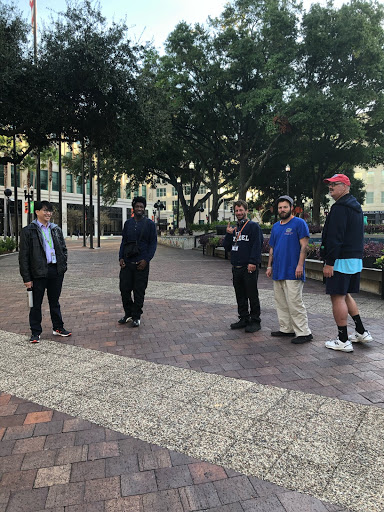Taking Steps Towards Health Access
“My name is Emily, and I am a National Health Corps Florida AmeriCorps member serving at the Sulzbacher Center in downtown Jacksonville” or so my intro spiel goes. However, that initial sentence doesn’t really describe my role or the things that I do day-to-day to increase access to health services for the clients I serve.
My purpose as a patient navigator at Sulzbacher is to organize our Patient Assistance Program by aiding clients in the application process to procure essential medicines, such as insulin or inhalers. In doing so, I am able to increase access to healthcare for those in our community who are without income, insurance, or both. My role in increasing our client’s access to health services is not limited to obtaining medications.
As part of my position, I have the flexibility to create health education courses, clubs, and opportunities for our patrons to pursue their health outcomes in a myriad of ways. One program I’ve implemented that has been particularly successful is our walking club. Every Wednesday at around 7 AM, I begin my day by chatting with our residents and individuals who are out in the campus courtyard. I ask, “Are you busy this morning? Feel like taking a walk?”
There are always a few who have appointments or continue to respond,  “Try me next week,” but I manage to get a solid group of 4 or 5, and we walk at least a mile every Wednesday morning. Initially, we began walking from Sulzbacher to Hemming Park and back. Recently, we’ve begun to expand to various murals around downtown and along the St. Johns River. Our group has also caught the eye of one of our volunteer clinicians from the University of North Florida who aids in running the cardio clinic on the first Friday of every month. The cardio clinic occurs once a month and is a time for patients of Sulzbacher to see a specialist regarding cardiac health conditions.
“Try me next week,” but I manage to get a solid group of 4 or 5, and we walk at least a mile every Wednesday morning. Initially, we began walking from Sulzbacher to Hemming Park and back. Recently, we’ve begun to expand to various murals around downtown and along the St. Johns River. Our group has also caught the eye of one of our volunteer clinicians from the University of North Florida who aids in running the cardio clinic on the first Friday of every month. The cardio clinic occurs once a month and is a time for patients of Sulzbacher to see a specialist regarding cardiac health conditions.
After seeing my flyers posted all over, she reached out to me to see if she or her students could help expand the program. We’ve begun talking about starting a similar program at the Sulzbacher Beaches clinic and collaborating so that participation is part of the curriculum for university students. We’ve also begun looking into ways to track our members progress. At the moment, we’ve been keeping track of the total mileage each participant has walked thus far. Soon we may have the ability to quantify the number of steps by use of pedometers.
 I’ve become increasingly more excited about this walking club because it provides me with opportunities for more patient interaction and allows me to really get to know and build relationships with them. By meeting every week, I provide a chance for patrons to take small steps in taking control of their own health outcomes and encourage the adoption of healthy habits. I chose a walking club because walking is a type of aerobic exercise that over time enables the heart to become more efficient in oxygen delivery to other organs. According to the American Heart Association, regular walking can reduce an individual's risk of a heart attack, lower “bad” cholesterol, lower blood pressure, help with weight management, and improve mood. I also chose walking because it’s a more inclusive form of exercise for a broad range of ability. When I asked a few of our participants to reflect and provide thoughts on the walking club and their experience members said, “Overall it’s a very positive group, and it works!” Here’s to taking steps towards continued health access!
I’ve become increasingly more excited about this walking club because it provides me with opportunities for more patient interaction and allows me to really get to know and build relationships with them. By meeting every week, I provide a chance for patrons to take small steps in taking control of their own health outcomes and encourage the adoption of healthy habits. I chose a walking club because walking is a type of aerobic exercise that over time enables the heart to become more efficient in oxygen delivery to other organs. According to the American Heart Association, regular walking can reduce an individual's risk of a heart attack, lower “bad” cholesterol, lower blood pressure, help with weight management, and improve mood. I also chose walking because it’s a more inclusive form of exercise for a broad range of ability. When I asked a few of our participants to reflect and provide thoughts on the walking club and their experience members said, “Overall it’s a very positive group, and it works!” Here’s to taking steps towards continued health access!

This post was authored by NHC Florida member Emily Parr.
Emily serves at Sulzbacher as a Patient Navigator.